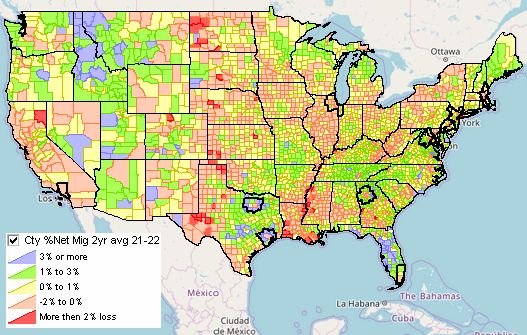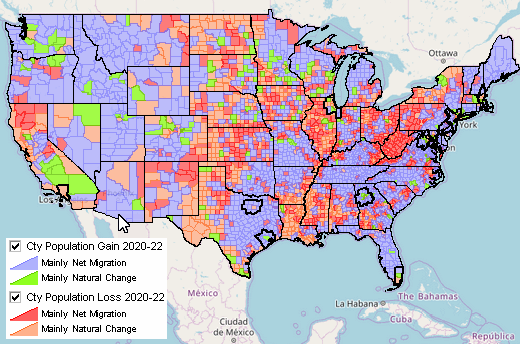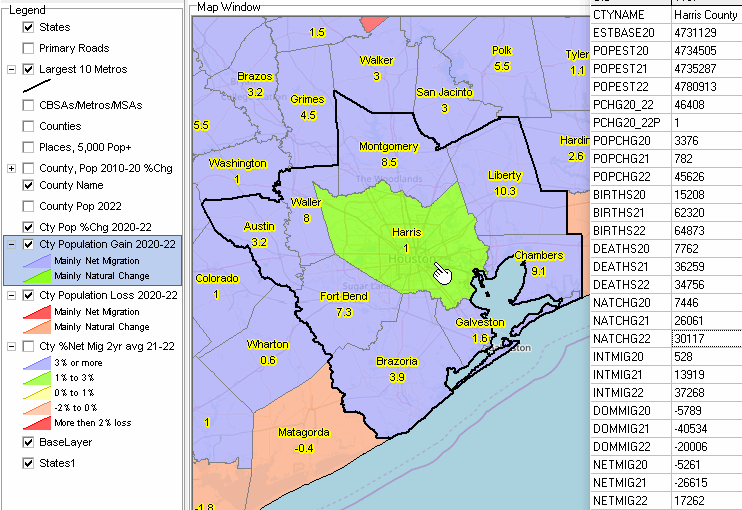

|
|
.. resources to create and apply insights April 2023 .. for many counties the pandemic has impacted each component of population change: births, deaths and migration. The magnitude and duration of the impact on each component varies by county and become more measurable in the months ahead. Counties, and county equivalent areas such as independent cities, are the primary political subdivision of states. The relative stable geography of counties, with good national scope geographic granularity, makes these areas appealing for use in tabulating data and analyzing demographic-economic data. This section provides information on tools and data related to accessing, integrating analyzing county demographic-economic patterns and trends. .. updates ,, interactive table Patterns of Percent Net Migration by County: 2021-2022 The following graphic shows patterns of percent net migration by county for the two-year period 7/1/20 to 6/30/22. See details below about how these data were computed. The largest ten metros (MSAs) are highlighted with bold black boundaries.  - click graphic for larger view and details. - the above view, and interactive variants, may be viewed using the CountyTrends GIS project with the VDA Web GIS. Join us in the weekly data analytics web sessions where CountyTrends topics are always included. Population & Components of Change Total population for an area can be computed as a sum of components of change: Population (7/1/22) = Population (7/1/21) + Births (6/30/21 to 7/1/22) - Deaths (6/30/21 to 7/1/22) + Net International Migration (6/30/21 to 7/1/22) + Net Domestic Migration (6/30/21 to 7/1/22) How & Why County Demographics are Changing: 2020-2022 .. goto top The following graphic shows how a county is changing (layers for gaining or losing population) and why a county is changing (interval for mainly net migration and interval for mainly natural chnage). The largest ten metros (MSAs) are highlighted with bold black boundaries.  - click graphic for larger view and details. - the above view, and interactive variants, may be viewed using the CountyTrends GIS project with the VDA Web GIS. For example, the computation to determine "gaining, mainly natural change" (green) is: (popest22-popest20)>0 and (netmig20+netmig21+netmig22)<=(natchg20+natchg21+natchg22) .. the determination for Harris County, TX is: (4780913-4734505)>0 and (-5261 + -26615 + 17262 )<=( 7446 + 26061 + 30117) or (46408)>0 and ((-14614)< (63624))  - click graphic for larger view and details. Selected County Geographic-Demographic-Economic Updates .. goto top ... scroll section
Outlook 2060: U.S. Demographic-Economic Projections to 2060
.. Annual projections 2010 to 2060 .. U.S., state, county population by single year of age, gender, race, origin with associated multi-sector economic projections. .. http://proximityone.com/demographic2060.htm County Population & Components of Change 2020-2022 .. goto top Interactive table Click column header to sort; again to sort other direction. Click ShowAll/Reset button between queries to refresh table. Usage notes below table. Interactive Table Usage Notes • Click ShowAll between queries/filters. • Use left-most column to select by state. • Find in Name button; click ShowAll button first .. click Find in Name button to search column 1 for text in edit box. .. text entered in edit box is case sensitive. .. partial names are okay to use. .. click with default value to view all rows with "Harris" (no quotes) • State-County FIPS Codes: http://proximityone.com/stcty.txt • Find in CBSA button; click ShowAll button first .. click Find in CBSA button to search column 4 for text in edit box. .. text entered in edit box must be the 5-character CBSA code. .. click with default value to view all rows with "26420" (no quotes) ... 26420 is the Houston, TX metro CBSA code .. how choose a different CBSA/metro: ... copy code from scroll list at right and paste into Find in CBSA edit box. ... then click Find in CBSA button. Selected columns buttons • Pop - click to view population columns. • NetChg - click to view net change columns. • Births - click to view births columns. • Deaths - click to view deaths columns. • NatInc - click to view natural increase columns. • IntMig - click to view international migration columns. • DomMig - click to view domestic migration columns. • NetMig - click to view net migration columns. • Population Min & Max> button .. click to show only peer group counties based on values in min and max edit boxes. .. enter the minimum 2019 population in the left edit box. .. enter the maximum 2019 population in the right edit box. • Click ShowAll between queries/filters. Items in Table
- Area Name
- USPS State abbreviation - State+County FIPS Code - CBSA code - Population estimate 7/1/2010 - Population estimate 7/1/2011 - Population estimate 7/1/2012 - Population estimate 7/1/2013 - Population estimate 7/1/2014 - Population estimate 7/1/2015 - Population estimate 7/1/2016 - Population estimate 7/1/2017 - Population estimate 7/1/2018 - Population change 7/1/2010-6/30/18 - Population percent change 7/1/2010-6/30/18 - Change in resident total population 7/1/2010 to 7/1/2011 - Change in resident total population 7/1/2011 to 7/1/2012 - Change in resident total population 7/1/2012 to 7/1/2013 - Change in resident total population 7/1/2013 to 7/1/2014 - Change in resident total population 7/1/2014 to 7/1/2015 - Change in resident total population 7/1/2015 to 7/1/2016 - Change in resident total population 7/1/2016 to 7/1/2017 - Change in resident total population 7/1/2017 to 7/1/2018 - Change in resident total population 7/1/2018 to 7/1/2019 - Births in period 7/1/2010 to 7/1/2011 - Births in period 7/1/2011 to 7/1/2012 - Births in period 7/1/2012 to 7/1/2013 - Births in period 7/1/2013 to 7/1/2014 - Births in period 7/1/2014 to 7/1/2015 - Births in period 7/1/2015 to 7/1/2016 - Births in period 7/1/2016 to 7/1/2017 - Births in period 7/1/2017 to 7/1/2018 - Births in period 7/1/2018 to 7/1/2019 - Deaths in period 7/1/2010 to 7/1/2011 - Deaths in period 7/1/2011 to 7/1/2012 - Deaths in period 7/1/2012 to 7/1/2013 - Deaths in period 7/1/2013 to 7/1/2014 - Deaths in period 7/1/2014 to 7/1/2015 - Deaths in period 7/1/2015 to 7/1/2016 - Deaths in period 7/1/2016 to 7/1/2017 - Deaths in period 7/1/2017 to 7/1/2018 - Deaths in period 7/1/2018 to 7/1/2019 - Natural increase in period 7/1/2010 to 7/1/2011 - Natural increase in period 7/1/2011 to 7/1/2012 - Natural increase in period 7/1/2012 to 7/1/2013 - Natural increase in period 7/1/2013 to 7/1/2014 - Natural increase in period 7/1/2014 to 7/1/2015 - Natural increase in period 7/1/2015 to 7/1/2016 - Natural increase in period 7/1/2016 to 7/1/2017 - Natural increase in period 7/1/2017 to 7/1/2018 - Natural increase in period 7/1/2018 to 7/1/2019 - Net international migration in period 7/1/2010 to 7/1/2011 - Net international migration in period 7/1/2011 to 7/1/2012 - Net international migration in period 7/1/2012 to 7/1/2013 - Net international migration in period 7/1/2013 to 7/1/2014 - Net international migration in period 7/1/2014 to 7/1/2015 - Net international migration in period 7/1/2015 to 7/1/2016 - Net international migration in period 7/1/2016 to 7/1/2017 - Net international migration in period 7/1/2017 to 7/1/2018 - Net international migration in period 7/1/2018 to 7/1/2019 - Net domestic migration in period 7/1/2010 to 7/1/2011 - Net domestic migration in period 7/1/2011 to 7/1/2012 - Net domestic migration in period 7/1/2012 to 7/1/2013 - Net domestic migration in period 7/1/2013 to 7/1/2014 - Net domestic migration in period 7/1/2014 to 7/1/2015 - Net domestic migration in period 7/1/2015 to 7/1/2016 - Net domestic migration in period 7/1/2016 to 7/1/2017 - Net domestic migration in period 7/1/2017 to 7/1/2018 - Net domestic migration in period 7/1/2018 to 7/1/2019 - Net migration in period 7/1/2010 to 7/1/2011 - Net migration in period 7/1/2011 to 7/1/2012 - Net migration in period 7/1/2012 to 7/1/2013 - Net migration in period 7/1/2013 to 7/1/2014 - Net migration in period 7/1/2014 to 7/1/2015 - Net migration in period 7/1/2015 to 7/1/2016 - Net migration in period 7/1/2016 to 7/1/2017 - Net migration in period 7/1/2017 to 7/1/2018 - Net migration in period 7/1/2018 to 7/1/2019 - Group Quarters Population estimate 7/1/2010 - Group Quarters Population estimate 7/1/2011 - Group Quarters Population estimate 7/1/2012 - Group Quarters Population estimate 7/1/2013 - Group Quarters Population estimate 7/1/2014 - Group Quarters Population estimate 7/1/2015 - Group Quarters Population estimate 7/1/2016 - Group Quarters Population estimate 7/1/2017 - Group Quarters Population estimate 7/1/2018 - Group Quarters Population estimate 7/1/2019 Computing Patterns of %Net Migration by County: 2021-2022 .. goto top The %net migration graphic above show patterns of %net migration by county for the two-year period 7/1/20 to 6/30/22. Intervals shonw in the legend panel are based on these end points (average of two years: (100*(NETMIG21/popest21)+100*(NETMIG22/popest22))/2 >=3 -- top interval where NETMIG21 .. net migration during the period 6/30/20 to 7/1/21 popest21 .. population as of 7/1/21 NETMIG22 .. net migration during the period 6/30/21 to 7/1/22 popest22 .. population as of 7/1/22 Support Using these Resources .. goto top Learn more about accessing and using ACS data integrated with other data; examine characteristics and patterns for your study areas and applications. Join us in a Decision-Making Information Web session. There is no fee for these one-hour Web sessions. Each informal session is focused on a specific topic. The open structure also provides for Q&A and discussion of application issues of interest to participants. Additional Information ProximityOne develops geographic-demographic-economic data and analytical tools and helps organizations knit together and use diverse data in a decision-making and analytical framework. We develop custom demographic/economic estimates and projections, develop geographic and geocoded address files, and assist with impact and geospatial analyses. Wide-ranging organizations use our tools (software, data, methodologies) to analyze their own data integrated with other data. Follow ProximityOne on Twitter at www.twitter.com/proximityone. Contact us (888-364-7656) with questions about data covered in this section or to discuss custom estimates, projections or analyses for your areas of interest. |
|
|